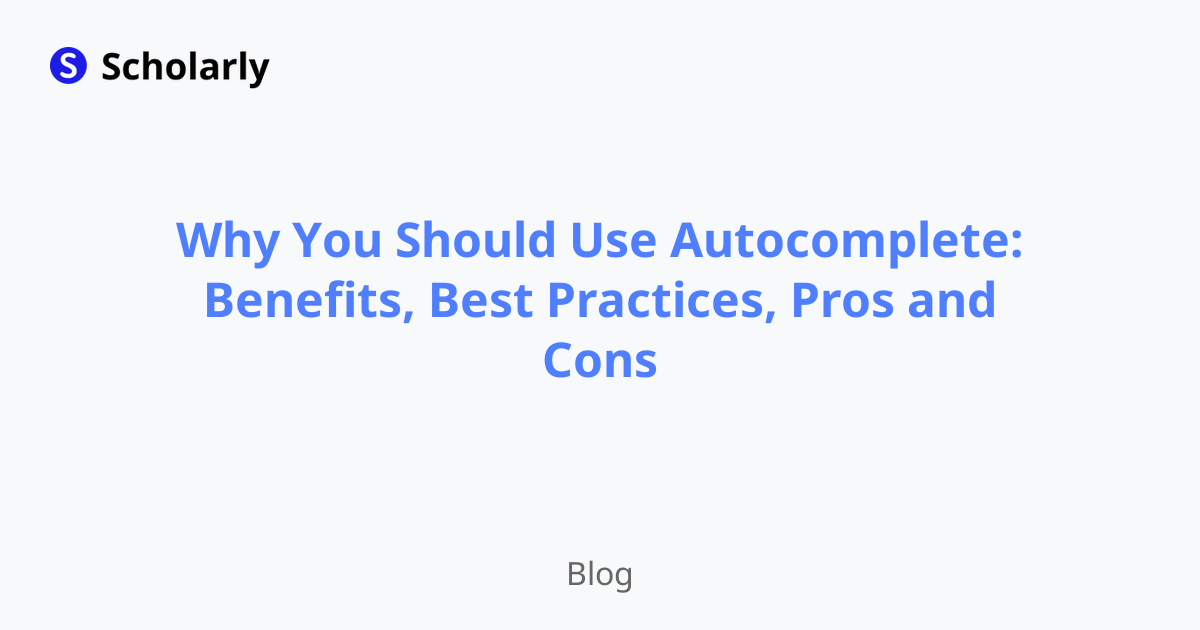Why You Should Use Autocomplete: Benefits, Best Practices, Pros and Cons
Discover the benefits, best practices, and pros and cons of using autocomplete for an improved user experience.

Autocomplete is a powerful tool that can greatly enhance the user experience on websites and applications. In this article, we will explore the benefits of using autocomplete, discuss best practices for implementing it, and weigh the pros and cons.
Introduction
Autocomplete is a feature that suggests completions or predictions to users as they type in a search box or input field. It saves users time and effort by providing suggestions based on previously entered queries, popular searches, or predefined terms.
Benefits
Saves Time: Autocomplete enables users to find what they are looking for more quickly by suggesting relevant options as they type. This minimizes the need to type out long queries or browse through a list of options.
Enhanced User Experience: Autocomplete provides a seamless and intuitive user experience by anticipating users' needs and simplifying the search or input process. It reduces frustration and improves overall satisfaction.
Increased Efficiency: With autocomplete, users can efficiently navigate large datasets or extensive product catalogs. It helps users find specific items or information without manually scrolling or filtering through a long list.
Reduced Errors: Autocomplete reduces the chance of user errors, such as misspellings or typos, by providing correct suggestions. It enhances the accuracy and relevance of search results, leading to more successful user interactions.
Mobile-Friendly: Autocomplete is especially beneficial on mobile devices with limited screen space and smaller keyboards. It speeds up the input process and ensures a smooth user experience on mobile platforms.
Best Practices
To leverage the full potential of autocomplete, consider the following best practices:
Use Relevant Suggestions: Provide suggestions that are contextually relevant to the user's query or input. Utilize user data and behavior to offer personalized and accurate autocomplete suggestions.
Display Clear and Concise Suggestions: Ensure that autocomplete suggestions are easy to read and understand. Keep the suggestions concise and avoid overwhelming the user with too many options.
Match User Expectations: Make sure autocomplete suggestions align with users' expectations. Use commonly used terms, industry jargon, or popular search queries to generate accurate suggestions.
Allow User Control: Give users the ability to choose whether they want to use autocomplete or disable it. Provide an option to easily turn off autocomplete suggestions if desired.
Optimize for Speed: Ensure that autocomplete suggestions are displayed instantaneously and do not introduce any noticeable delay. Users should experience a seamless and real-time autocomplete functionality.
Pros and Cons
Pros
Improved User Experience: Autocomplete enhances the user experience by providing relevant and personalized suggestions, leading to quicker and more accurate searches.
Time-saving: Autocomplete saves users time by predicting their queries and offering suggestions, eliminating the need for lengthy and repetitive typing.
Increased Efficiency: With autocomplete, users can efficiently navigate complex datasets, making it easier to find desired information.
Reduced Errors: Autocomplete minimizes spelling errors and typos, ensuring that users receive accurate search results.
Mobile-Friendly: Autocomplete is particularly valuable for mobile users, as it speeds up the input process on smaller screens.
Cons
Privacy Concerns: Implementing autocomplete requires collecting and analyzing user data, which may raise privacy concerns for some users.
Overwhelming Suggestions: An excessive number of autocomplete suggestions can overwhelm users and make it difficult to find what they need.
Limited Discoverability: Autocomplete may limit users' exposure to new or alternative search options, potentially restricting their exploration.
Technical Challenges: Implementing an effective autocomplete feature can be complex, requiring expertise in data analysis, algorithm design, and user interface design.
Language and Context Limitations: Autocomplete may struggle with understanding nuanced or colloquial language, as well as context-specific queries.
Comparison
Autocomplete functionality is available through various tools and platforms. Let's compare two popular autocomplete solutions:
Google Autocomplete: Google Autocomplete is a widely used tool that predicts search queries based on popular searches and the user's search history. It offers accurate and real-time suggestions, enhancing the search experience.
jQuery UI Autocomplete: jQuery UI Autocomplete is a popular autocomplete plugin that provides a customizable and flexible solution. It supports various data sources, including local arrays, remote data retrieval, and JSON responses.
AI Impact
Artificial intelligence (AI) has contributed to the advancement of autocomplete functionality.
AI Applications: AI technologies enable more accurate and personalized autocomplete suggestions based on user behavior, context, and trends.
AI Techniques: Natural language processing (NLP) and machine learning algorithms are employed to analyze user queries and generate relevant suggestions.
AI Benefits: AI-powered autocomplete enhances the user experience, improves search accuracy, and increases overall efficiency.
AI Challenges: AI-powered autocomplete requires substantial computational resources, data processing capabilities, and ongoing training and optimization.
AI Online Apps: There are several AI-powered online apps that offer advanced autocomplete features, such as Scholarly (https://scholarly.so), which utilizes AI-generated text completion and flashcard creation for efficient studying.
Conclusion
Autocomplete is a valuable feature that brings numerous benefits to users and businesses. It saves time, enhances user experience, increases efficiency, reduces errors, and improves mobile usability. However, it is essential to consider best practices, weigh the pros and cons, and leverage AI advancements to ensure the effective implementation of autocomplete. By following these guidelines, websites and applications can provide a seamless and intuitive user experience, making browsing and searching more efficient and enjoyable.
Try Our Popular AI Study Tools
Transform your study materials into interactive learning experiences with our most popular AI-powered tools:
PDF to Flashcards
Convert lecture notes and textbooks into study flashcards instantly
Text to Flashcards
Turn any text or notes into comprehensive flashcard sets
Image to Flashcards
Convert diagrams and handwritten notes into digital flashcards
YouTube to Flashcards
Generate flashcards from educational video content



